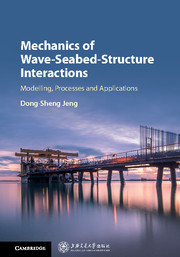Book contents
- Frontmatter
- Contents
- Preface
- 1 Overview
- 2 Basic Seabed Mechanisms
- 3 Soil Response in Marine Sediments under Combined Loading of Waves and Currents
- 4 Integrated Model of Wave-Seabed Interactions around Caisson-Type Breakwaters
- 5 Mechanics of Wave-Seabed-Pipeline Interactions
- 6 Three-Dimensional Model of Wave-Seabed Interactions around Breakwater Heads
- 7 Seabed Instability around Offshore Wind Turbine Foundations
- 8 Physical Modelling: One-Dimensional Compressive Tests
- Appendix A Analytical Solution for a Seabed of Finite Thickness (Hsu & Jeng 994)
- Appendix B Derivation of u–p Approximation (Jeng et al. 1999)
- Appendix C Derivation of u–U Approximation (Cha et al. 2002)
- Appendix D Mathematical Derivations of Analytical Solutions for Residual Soil Response (Jeng et al. 2007)
- Appendix E Mathematical Model of the Two-Layered Viscous Fluid System (Liu et al. 2009)
- References
- Author Index
- Subject Index
Preface
Published online by Cambridge University Press: 28 April 2018
- Frontmatter
- Contents
- Preface
- 1 Overview
- 2 Basic Seabed Mechanisms
- 3 Soil Response in Marine Sediments under Combined Loading of Waves and Currents
- 4 Integrated Model of Wave-Seabed Interactions around Caisson-Type Breakwaters
- 5 Mechanics of Wave-Seabed-Pipeline Interactions
- 6 Three-Dimensional Model of Wave-Seabed Interactions around Breakwater Heads
- 7 Seabed Instability around Offshore Wind Turbine Foundations
- 8 Physical Modelling: One-Dimensional Compressive Tests
- Appendix A Analytical Solution for a Seabed of Finite Thickness (Hsu & Jeng 994)
- Appendix B Derivation of u–p Approximation (Jeng et al. 1999)
- Appendix C Derivation of u–U Approximation (Cha et al. 2002)
- Appendix D Mathematical Derivations of Analytical Solutions for Residual Soil Response (Jeng et al. 2007)
- Appendix E Mathematical Model of the Two-Layered Viscous Fluid System (Liu et al. 2009)
- References
- Author Index
- Subject Index
Summary
The phenomenon of the wave-seabed-structure interaction has attracted extreme attention among coastal and geotechnical engineers in recent years. Intensive research activities in the area have been carried out by numerous research groups across the world. Understanding of the mechanisms and processes of the wave-seabed-structure interaction problem is particularly important for marine geotechnical engineers involved in the design of foundations around marine infrastructures. The aim of this book is to provide readers with a comprehensive theoretical background for the wave-induced soil response in marine sediments around marine infrastructures, covering various aspects.
This book consists of eight chapters. The first chapter sets out the background to the topic, describes recent advances in the area and explores possible future research agendas. This chapter is a useful starting point for postgraduate students, and provides junior researchers and readers new to this discipline with an overall picture of the research topic. Chapter 2 presents detailed mathematical formulations for the wave-induced soil response, including pore pressure, effective stresses and soil displacements. This chapter summarises the key processes from my first book (Porous Models for Wave-Seabed Interactions, published by Springer in 2013) and some additional new results. Chapter 3 presents analytical and numerical models for the seabed response subject to combined wave and current loading. In Chapters 4 and 5, two-dimensional marine infrastructures are considered. Among these, seabed response around caisson-type breakwaters is presented in Chapter 4. The cases of a submerged breakwater and a breakwater on a sloping seabed are included in the chapter. In Chapter 5, offshore pipelines are considered, including those fully and partially buried in a trench layer. In Chapters 6 and 7, three-dimensional model are presented for two different types of marine infrastructures: breakwaters and offshore wind turbine foundations. Chapter 6 provides an intensive study for the soil response around breakwater heads, while Chapter 7 presents the case of conventional offshore wind turbine foundations such as monopiles and a case study at Donghai offshore wind farms. Finally, Chapter 8 presents results of the recent laboratory experiments on the wave-induced oscillatory pore pressures, including sand-clay mixtures.
- Type
- Chapter
- Information
- Mechanics of Wave-Seabed-Structure InteractionsModelling, Processes and Applications, pp. xi - xiiPublisher: Cambridge University PressPrint publication year: 2018

